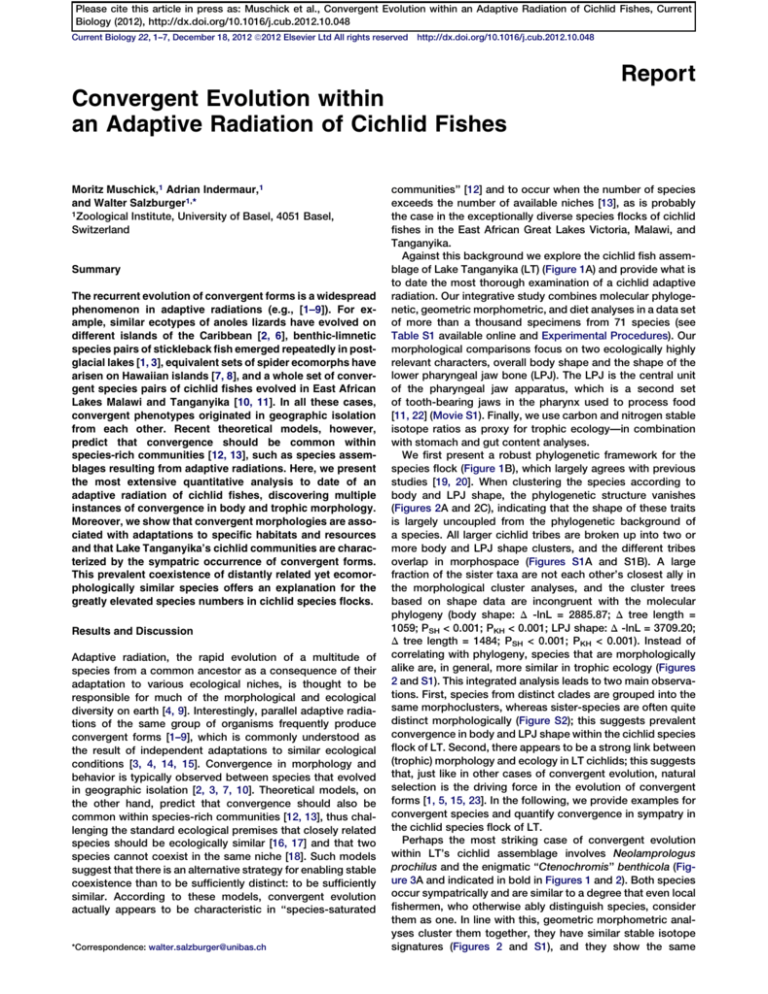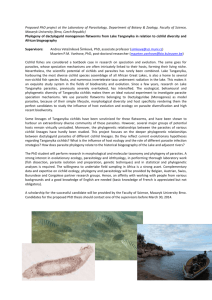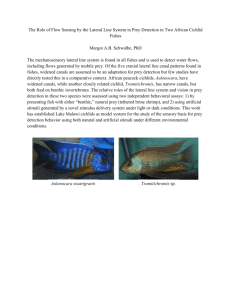
Please cite this article in press as: Muschick et al., Convergent Evolution within an Adaptive Radiation of Cichlid Fishes, Current
Biology (2012), http://dx.doi.org/10.1016/j.cub.2012.10.048
Current Biology 22, 1–7, December 18, 2012 ª2012 Elsevier Ltd All rights reserved
http://dx.doi.org/10.1016/j.cub.2012.10.048
Report
Convergent Evolution within
an Adaptive Radiation of Cichlid Fishes
Moritz Muschick,1 Adrian Indermaur,1
and Walter Salzburger1,*
1Zoological Institute, University of Basel, 4051 Basel,
Switzerland
Summary
The recurrent evolution of convergent forms is a widespread
phenomenon in adaptive radiations (e.g., [1–9]). For example, similar ecotypes of anoles lizards have evolved on
different islands of the Caribbean [2, 6], benthic-limnetic
species pairs of stickleback fish emerged repeatedly in postglacial lakes [1, 3], equivalent sets of spider ecomorphs have
arisen on Hawaiian islands [7, 8], and a whole set of convergent species pairs of cichlid fishes evolved in East African
Lakes Malawi and Tanganyika [10, 11]. In all these cases,
convergent phenotypes originated in geographic isolation
from each other. Recent theoretical models, however,
predict that convergence should be common within
species-rich communities [12, 13], such as species assemblages resulting from adaptive radiations. Here, we present
the most extensive quantitative analysis to date of an
adaptive radiation of cichlid fishes, discovering multiple
instances of convergence in body and trophic morphology.
Moreover, we show that convergent morphologies are associated with adaptations to specific habitats and resources
and that Lake Tanganyika’s cichlid communities are characterized by the sympatric occurrence of convergent forms.
This prevalent coexistence of distantly related yet ecomorphologically similar species offers an explanation for the
greatly elevated species numbers in cichlid species flocks.
Results and Discussion
Adaptive radiation, the rapid evolution of a multitude of
species from a common ancestor as a consequence of their
adaptation to various ecological niches, is thought to be
responsible for much of the morphological and ecological
diversity on earth [4, 9]. Interestingly, parallel adaptive radiations of the same group of organisms frequently produce
convergent forms [1–9], which is commonly understood as
the result of independent adaptations to similar ecological
conditions [3, 4, 14, 15]. Convergence in morphology and
behavior is typically observed between species that evolved
in geographic isolation [2, 3, 7, 10]. Theoretical models, on
the other hand, predict that convergence should also be
common within species-rich communities [12, 13], thus challenging the standard ecological premises that closely related
species should be ecologically similar [16, 17] and that two
species cannot coexist in the same niche [18]. Such models
suggest that there is an alternative strategy for enabling stable
coexistence than to be sufficiently distinct: to be sufficiently
similar. According to these models, convergent evolution
actually appears to be characteristic in ‘‘species-saturated
*Correspondence: walter.salzburger@unibas.ch
communities’’ [12] and to occur when the number of species
exceeds the number of available niches [13], as is probably
the case in the exceptionally diverse species flocks of cichlid
fishes in the East African Great Lakes Victoria, Malawi, and
Tanganyika.
Against this background we explore the cichlid fish assemblage of Lake Tanganyika (LT) (Figure 1A) and provide what is
to date the most thorough examination of a cichlid adaptive
radiation. Our integrative study combines molecular phylogenetic, geometric morphometric, and diet analyses in a data set
of more than a thousand specimens from 71 species (see
Table S1 available online and Experimental Procedures). Our
morphological comparisons focus on two ecologically highly
relevant characters, overall body shape and the shape of the
lower pharyngeal jaw bone (LPJ). The LPJ is the central unit
of the pharyngeal jaw apparatus, which is a second set
of tooth-bearing jaws in the pharynx used to process food
[11, 22] (Movie S1). Finally, we use carbon and nitrogen stable
isotope ratios as proxy for trophic ecology—in combination
with stomach and gut content analyses.
We first present a robust phylogenetic framework for the
species flock (Figure 1B), which largely agrees with previous
studies [19, 20]. When clustering the species according to
body and LPJ shape, the phylogenetic structure vanishes
(Figures 2A and 2C), indicating that the shape of these traits
is largely uncoupled from the phylogenetic background of
a species. All larger cichlid tribes are broken up into two or
more body and LPJ shape clusters, and the different tribes
overlap in morphospace (Figures S1A and S1B). A large
fraction of the sister taxa are not each other’s closest ally in
the morphological cluster analyses, and the cluster trees
based on shape data are incongruent with the molecular
phylogeny (body shape: D -lnL = 2885.87; D tree length =
1059; PSH < 0.001; PKH < 0.001; LPJ shape: D -lnL = 3709.20;
D tree length = 1484; PSH < 0.001; PKH < 0.001). Instead of
correlating with phylogeny, species that are morphologically
alike are, in general, more similar in trophic ecology (Figures
2 and S1). This integrated analysis leads to two main observations. First, species from distinct clades are grouped into the
same morphoclusters, whereas sister-species are often quite
distinct morphologically (Figure S2); this suggests prevalent
convergence in body and LPJ shape within the cichlid species
flock of LT. Second, there appears to be a strong link between
(trophic) morphology and ecology in LT cichlids; this suggests
that, just like in other cases of convergent evolution, natural
selection is the driving force in the evolution of convergent
forms [1, 5, 15, 23]. In the following, we provide examples for
convergent species and quantify convergence in sympatry in
the cichlid species flock of LT.
Perhaps the most striking case of convergent evolution
within LT’s cichlid assemblage involves Neolamprologus
prochilus and the enigmatic ‘‘Ctenochromis’’ benthicola (Figure 3A and indicated in bold in Figures 1 and 2). Both species
occur sympatrically and are similar to a degree that even local
fishermen, who otherwise ably distinguish species, consider
them as one. In line with this, geometric morphometric analyses cluster them together, they have similar stable isotope
signatures (Figures 2 and S1), and they show the same
Please cite this article in press as: Muschick et al., Convergent Evolution within an Adaptive Radiation of Cichlid Fishes, Current
Biology (2012), http://dx.doi.org/10.1016/j.cub.2012.10.048
Current Biology Vol 22 No 24
2
Figure 1. The Cichlid Species Flock of Lake Tanganyika
(A) Map of East Africa showing the three Great Lakes. Lake Tanganyika (LT) is the oldest lake in East Africa and, consequently, accommodates the genetically, morphologically, and ecologically most diverse cichlid species flock [11, 19].
(B) Maximum-likelihood phylogeny of the 71 Tanganyikan cichlid species in our core data set, based on two nuclear (ednrb1, phpt1) and one mitochondrial
(ND2) marker (2,013 bp in total) and the GTR+G model of molecular evolution. Numbers above the branches depict Bayesian posterior probabilities >0.97.
Full species names are given in Table S1; different colors denote the main cichlid lineages (‘‘tribes’’), some of which are likely to have undergone secondary
subradiations [19–21]. Note that the cichlid adaptive radiations of Lakes Malawi and Victoria consist of one of these tribes only, the Haplochromini (the Tanganyikan representatives of which are often referred to as Tropheini) [21]. Our phylogeny confirms the monophyly of the tribes; at least seven genera
are, however, paraphyletic, which already indicates convergence in traits used to classify them initially. For example, the putative haplochromine
‘‘Ctenochromis’’ benthicola (Cteben) emerges as a member of the Cyphotilapiini, whereas its congener, C. horei (Ctehor) remains within the Tropheini/
Haplochromini. The other paraphyletic genera are Gnathochromis (Gna), Lamprologus (Lam), Limnochromis (Lch), Neolamprologus (Neo), Perissodus
(Per), and Petrochromis (Pet). Images of the fishes were taken directly in the field.
stomach contents, namely remnants of the endemic shrimp
Limnocaridina sp. (Figure 3A). Yet, whereas N. prochilus
belongs to the Lamprologini, ‘‘C.’’ benthicola—formerly considered a Haplochromini and congener of C. horei—now
emerges as a member of the Cyphotilapiini (Figure 1B). Pairwise genetic distances of 10.6% and 1.4% in the mitochondrial
and nuclear DNA, respectively, suggest that the two species
are separated by several million years of independent evolution, which lies in the range of the eye-catching convergent
species pairs observed between Lakes Tanganyika and
Malawi [10]. But cichlids do not only resemble other endemic
cichlids. The rare Baileychromis centropomoides, for
example, is very similar in overall body shape to an endemic
Lates sp. (Figures 3B and S3).
To quantify convergence in the LT cichlid species flock, we
plotted relative morphological distance against phylogenetic
distance for each pair of species and compared it to simulations of trait evolution (Figure 4A). Applying a conservative
threshold (see Experimental Procedures), we identify 122
and 132 species pairs that are convergent in body and LPJ
shape, respectively, which is about five times more than predicted by the models. Importantly, more than three quarters
of these convergent species pairs overlap in habitat and depth
distribution (Table S2), and they show a significantly greater
Please cite this article in press as: Muschick et al., Convergent Evolution within an Adaptive Radiation of Cichlid Fishes, Current
Biology (2012), http://dx.doi.org/10.1016/j.cub.2012.10.048
Convergence within a Cichlid Adaptive Radiation
3
Figure 2. Ecomorphological Diversity in Cichlids from Lake Tanganyika
(A) Cluster analysis on the basis of 17 homologous landmarks on body shape.
(B) d13C stable isotope signatures.
(C) Cluster analysis on the basis of eight homologous and six sliding landmarks on the lower pharyngeal jaw bone.
(D) d15N stable isotope signatures.
(E) Results from the stomach and gut content analyses (in volume %).
Outlines in (A) are based on real photographs; images in (C) are taken from dissected LPJs (see Table S1 for details). The main morphoclusters are separated
by gray lines, and the tribes are colored as in Figure 1. Colored dots in (B) and (D) represent average values; gray bars indicate 95% confidence limits of a t
distribution. * marks species with too small a sample size, so that 95% confidence intervals were not calculated. The ratio between the rare isotope 13C to 12C
(the d13C value) indicates the primary carbon source, which may vary between macrohabitats (e.g., benthic versus pelagic), whereas the d15N value (15N to 14N)
serves as proxy for the relative trophic level of an organism. Accordingly, in LT cichlids, d13C values correlate with body shape clusters (F = 2.66, p < 0.005),
whereas d15N values correlate with LPJ shape (F = 4.03, p < 0.005). Note that each trophic level is separated by approximately 3.4‰ in d15N from the one
below. To facilitate comparisons, we also included average stable isotope values for some plant and animal species from LT (see box at the bottom).
Please cite this article in press as: Muschick et al., Convergent Evolution within an Adaptive Radiation of Cichlid Fishes, Current
Biology (2012), http://dx.doi.org/10.1016/j.cub.2012.10.048
Current Biology Vol 22 No 24
4
Figure 3. The Curious Cases of Convergent
Evolution between ‘‘Ctenochromis’’ benthicola
and Neolamprologus prochilus and between
Baileychromis centropomoides and Lates sp.
(A) ‘‘C.’’ benthicola (Cteben) and N. prochilus
(Neopro) are phylogenetically distinct (Figure 1)
but show great similarities in morphology and in
stable isotope signatures (Figure 2). For each
species, the LPJ and a pincer of the freshwater
shrimp Limnocaridina sp. (found in the stomach
of the respective specimen) is shown.
(B) Canonical variates analysis showing that
B. centropomoides is morphologically similar to
Lates sp. endemic to LT (B. centropomoides
shows the by far smallest Procrustes distance
to Lates; see Figure S3). Each dot represents
a species. Note that Lates used to be classified
in the family Centropomidae until recently, which
is where the species name for Baileychromis is
derived from.
overlap in diet compared to random species pairs (p < 0.05 for
body shape; p < 0.0001 for LPJ shape). These results demonstrate that cichlid communities within LT are characterized by
the sympatric occurrence of convergent forms and that
convergence is particularly prevalent in trophic morphology.
We then performed disparity-through-time (DTT) analyses
to reconstruct convergent evolution along the evolutionary
history of the species flock. The DTT analysis uncovers a large
overlap in body morphology between the subclades emerging
in the progress of the radiation (Figure 4B). The DTT plots on
the basis of LPJ shape reveal that phases of larger subclade
overlap are punctuated by a phase of neutral-like disparity.
Overall, there is a strong signal of convergent evolution, which
is unlikely to be explained by varying rates of speciation or of
morphological evolution, because both have been shown to
be rather constant in the cichlid adaptive radiation of LT [20,
25] (Figure S4). The DTT analyses thus suggest that convergent evolution in body and LPJ shape occurred throughout
the time course of the radiation.
A large proportion of phenotypic
differentiation in LT’s cichlid assemblage occurred along only a few principal axes in morphospace (Figure 4C),
which reflect adaptations to specific
habitats and feeding regimes. For body
shape, we detect divergence and
convergence in the relative body height,
which generally correlates with a pelagic
or benthic lifestyle, respectively; the
relative sizes of the head and trunk;
the sizes of mouth and eye; and the
position of the mouth. The divergent
and convergent features of the LPJ
involve its relative length and width
(affecting lever ratios), the relative size
and position of the posterior horns
(important muscle attachment sites),
and the shape of the toothed area. Interestingly, the DTT trajectory for LPJ
shape largely coincides with the trajectory of the stable isotope data (Figure 4B), underpinning synchronized
differentiation in both an important
trophic character (the pharyngeal jaw apparatus) and the
trophic niche (as approximated by stable isotopes). This
once more confirms a strong link between morphology and
ecology in LT cichlids.
In comparison with other renowned examples of adaptive
radiation, the situation in LT is unique in its richness of convergent forms that evolved in situ and that coexist in the same
habitats (Figures 2, 3, and 4). But what has triggered convergent evolution within the species flock of cichlids in LT? One
possibility is that convergent evolution is a feature of
advanced adaptive radiations, such as the LT cichlid species
flock, which constitutes the relatively oldest cichlid radiation
of the East African lakes. Representatives of distant lineages
that independently adapt to the same habitat and the
resources therein later in the radiation might then already be
sufficiently distinct in certain life-history traits to enable coexistence. In the convergent species pair N. prochilus and ‘‘C.’’
benthicola (Figure 3), for example, the former is a substrate
spawner, whereas the latter is a mouthbrooder. Convergence
Please cite this article in press as: Muschick et al., Convergent Evolution within an Adaptive Radiation of Cichlid Fishes, Current
Biology (2012), http://dx.doi.org/10.1016/j.cub.2012.10.048
Convergence within a Cichlid Adaptive Radiation
5
Figure 4. Convergence and Adaptive Disparity in
the Cichlid Species Flock in Lake Tanganyika
(A) Pairwise distance-contrast plots showing the
correlation between phylogenetic versus
morphological distance. The expectation from
neutral trait evolution (‘‘divergence’’) is a correlation between morphological and phylogenetic
distance. Species pairs with small morphological
yet large phylogenetic distance are indicative of
stasis (in cases where there are no intermediate
species with distinct morphologies) or convergent evolution [24]. To assess the prevalence of
convergent evolution in body and jaw shape, we
contrasted the positions occupied by all pairwise
comparisons (n = 2,485) with those resulting from
a Brownian motion model of trait evolution. We
binned the data points into hexagons, the colors
of which reflect the differential abundance of
observed versus model comparisons. Different
shades of blue indicate that our data contained
fewer comparisons than expected from the
model, whereas shades of red indicate that there
were more pairwise comparisons in the data. The
latter are predominant in the area indicative for
convergence. The white asterisk marks the
convergent species pair ‘‘Ctenochromis’’ benthicola and Neolamprologus prochilus (see Figure 3).
(B) Disparity-through-time (DTT) plots showing
the average disparity retained in subclades (for
body shape and LPJ shape and stable isotopes).
Here, DTT plots inform about the time course of
ecomorphological evolution. Moving along the
phylogeny (from the root to the tips), the relative
disparity of subclades is calculated at each
internal node, averaged, and plotted against
evolutionary time. The observed data is
compared to a scenario of trait evolution estimated under a Brownian motion model (dotted
line) on the same phylogeny. In order to avoid
the effects of ‘‘tip overdispersion’’ due to missing
terminal taxa, the most recent 20% of the plots
were omitted.
(C) Shape changes along axes, which account for most of the divergence in the LT cichlid radiation. Axes are derived from evolutionary principal component
analyses for body (first, second, and fourth axis) and LPJ shape (first, second, and third axis). The relative variance explained by each axis is given in percent.
(and niche overlap) would then be the product of secondary
subradiations within the main Tanganyikan tribes [19, 20]
superimposed upon each other—a stage that other adaptive
radiations might not yet have reached. This scenario seems
unlikely, though, given that our DTT analyses reveal a signal
of convergence that is constantly high throughout the radiation (Figure 4B). Also, empirical studies comparing various
adaptive radiations [26] and theoretical work [27] revealed
that diversity appears to be greatest in radiations of intermediate ages and to actually decrease toward later stages. A
second possibility is that convergent species initially emerged
in isolation—e.g., when LT was temporarily split into separate
basins during extremely low lake stands [28]—and only
became admixed at a later stage of their evolution. Again,
this does not seem to be compatible with our DTT and LTT
analyses, which revealed that the signal of divergence and
convergence is rather constant throughout the radiation and
not restricted to certain periods—e.g., of lake level low
stands—only.
That morphological differentiation resulted in convergence
in LT might better be explained by the limited number of niches
and, hence, adaptive zones (compared to the number of
species) that cichlids can invade within the lake [29].
Alternatively, there might be a limit in the number of possible
morphologies that cichlids can produce, due to some sort of
developmental or genetic constraint [14]. The main morphoclusters in body and LPJ shape (Figure 2) might reflect
such constraints. Perhaps it is also a combination of the finite
number of niches and morphologies that explains convergence within the adaptive radiation of LT cichlids.
In any case, convergence in ecologically relevant traits
within a single radiation is compatible with predictions made
by current population ecology theory [12, 13]. It seems that
self-organized similarity does not only play an important role
in the maintenance of diversity, for example of plankton [30],
but also in the rapid formation of organismal diversity via
convergent evolution. Because resources are jointly used by
several ecomorphologically similar and co-occurring cichlid
species from distinct clades in LT, species numbers are maximized without increasing overall disparity. A key to the cichlid
problem (i.e., why are there so many species?) might thus lie in
the frequent occurrence of convergent evolution—not only
between lakes but especially within a single lake and in adaptively relevant traits such as the LPJ. The question is now
whether divergence via convergence is a more general pattern
of diversification in species-rich communities. It would thus be
Please cite this article in press as: Muschick et al., Convergent Evolution within an Adaptive Radiation of Cichlid Fishes, Current
Biology (2012), http://dx.doi.org/10.1016/j.cub.2012.10.048
Current Biology Vol 22 No 24
6
of great interest to extend the kind of integrative analysis
implemented in this study to other adaptive radiations and,
especially, to the cichlid adaptive radiations in Lakes Malawi
and Victoria. Even more so, because a recent comparison
across 46 cichlid adaptive radiations [31] suggests that the
LT radiation is an outlier from an otherwise more general trend
in cichlid radiations, which appear to be triggered by both
ecological opportunity and sexual selection.
Experimental Procedures
Sampling
Sampling was performed under permission from the Department of Fisheries, Lake Tanganyika Research Unit, Mpulungu, Zambia. In total, we
sampled more than 1,000 specimens for this study (see Supplemental
Experimental Procedures and Table S1 for further details).
Phylogenetic Analyses
We analyzed one mitochondrial (ND2) and two nuclear (ednrb1, phpt)
markers (see Supplemental Experimental Procedures and Table S1 for
GenBank accession numbers used in this study). We relied on maximum
likelihood and Bayesian methods for phylogenetic analysis using PAUP*,
MRBAYES, and the BEAST package. The appropriate model of molecular
evolution for the heuristic tree searches in PAUP* was determined with
JMODELTEST; MRBAYES was run for ten million generations with a burnin of 10%; data were partitioned in BEAST. We first analyzed our core
data set combining the mitochondrial and nuclear DNA sequences in 71
taxa, then the core data set including Baileychromis centropomoides,
and, finally, a mitochondrial data set including the ND2 sequences of 180
taxa (i.e., ca. 90% of all Tanganyika species). Trees derived from the latter
analysis were used for lineage-through-time plots. For incongruence
testing, we applied the Kishino-Hasegawa (KH) and the ShimodairaHasegawa (SH) test implemented in PAUP*.
Geometric Morphometric and Morphological Analyses
We assessed the body shape of 1,049 individuals using landmark-based
geometric morphometrics. xy coordinates of 17 landmarks, distributed
across the whole fish body (see Figure S5A), and the scale of each picture
were recorded using TPSDIG [32]. Aligned Procrustes coordinates were
used for a pooled-within-species regression of shape against centroid
size in MORPHOJ 1.02d [33]. Species averages were then used for principal
component analysis (PCA), for disparity-through-time analyses, and for the
calculation of pairwise distances between species. For LPJ assessment we
recorded coordinates of eight true landmarks and 20 semilandmarks
describing the outline of the bone (Figure S5B). We then clustered the
species according to similarity in body and LPJ shape, using agglomerative
hierarchical clustering in R.
between simulations and data (each 1/10 of the x axis) by bootstrapping
(1,000 replications).
Disparity-through-Time Analysis
DTT analyses were performed according to Harmon et al. [34], comparing the observed data to a scenario of trait evolution estimated under a
Brownian motion model. Positive deviations of the data from the simulations
indicate a higher overlap in morphospace among subclades than would be
expected under neutral evolution.
Evolutionary PCA
We estimated the ancestral character states for body and LPJ shape at
each node in the phylogeny and calculated the extent and the direction of
shape change along each branch. These branchwise estimates were then
subjected to PCA to find the axes of greatest evolutionary divergence. All
evolutionary PCAs were performed in MORPHOJ.
Supplemental Information
Supplemental Information includes five figures, two tables, Supplemental
Experimental Procedures, and one movie and can be found with this article
online at http://dx.doi.org/10.1016/j.cub.2012.10.048.
Acknowledgments
We thank H. Büscher and various past and present members of the SalzburgerLab for help during fieldwork campaigns; S. Koblmüller for discussions
and help with species identifications; B. Aeschbach, N. Boileau, and
F. Münzel for assistance in the lab; M. Lehmann for help with stable isotope
analyses; H. Bichsel, T. Bosia, M. Gschwind, I. Keller, M. Maurer, N. Rose,
and F. Ronco for help with the stomach content analyses; F. Meury, D.
Moser, W. Moser, and C. Mullis for assistance with transect surveys; J.P.
Montoya and S. Chraiti for help with the CT scans; the Department of Fisheries, Republic of Zambia, for research permits and technical support; and
H. Büscher, L. Harmon, L. Keller, C.P. Klingenberg, J.B. Losos, P. Nosil, S.
Ramm, L. Schärer, M. Scheffer, D. Schluter, J.T. Streelman, M. Taylor, the
SalzburgerLab, and two anonymous referees for discussion and valuable
comments. This work was supported by the European Research Council
(ERC; Starting Grant ‘‘INTERGENADAPT’’), the Swiss National Science
Foundation, the National Geographic Society, and the University of Basel.
Received: September 12, 2012
Revised: October 25, 2012
Accepted: October 29, 2012
Published: November 15, 2012
References
Stomach and Gut Content Analyses
Contents were removed from the intestinal tracts of 506 specimens and
separated up into one or more of the following categories: sand, aufwuchs
(algae), plant material, mollusks, insects (imagines and larvae), crustaceans,
fish (remains), fish eggs, and fish scales. We determined volume (in %) and
weight (in mg) of each category.
Stable Isotope Analysis
White muscle tissue from 727 specimens (see Table S1) was dried,
pulverized, and analyzed on an elemental analyzer (Thermo Finnigan)
coupled to a Finnigan Delta V Advantage Isotope Ratio Mass Spectrometer
(IRMS).
Pairwise Distance-Contrast Plots
To estimate the extent of convergence, we compared the phylogenetic
distance to the morphological distance of each species pair [24]. The
morphological distance was calculated as Euclidean distance from the
pooled-within-species regressions of shape against centroid size using
R’s dist() function. In total, we had 2,485 species comparisons; therefore,
we used hexagonal binning (x = 10 bins) to overcome overplotting. We
also simulated neutral trait evolution on the phylogeny, using Brownian
motion and Ornstein-Uhlenbeck models. Species comparisons that we
derived from these simulations were then compared to our actual data by
subtracting the binning counts of the simulations from those of the data.
We tested for statistical significance of the difference of pointwise means
1. Schluter, D., and Nagel, L.M. (1995). Parallel speciation by natural
selection. Am. Nat. 146, 292–301.
2. Losos, J.B., Jackman, T.R., Larson, A., Queiroz, K., and RodriguezSchettino, L. (1998). Contingency and determinism in replicated
adaptive radiations of island lizards. Science 279, 2115–2118.
3. Rundle, H.D., Nagel, L., Wenrick Boughman, J., and Schluter, D. (2000).
Natural selection and parallel speciation in sympatric sticklebacks.
Science 287, 306–308.
4. Schluter, D. (2000). The Ecology of Adaptive Radiation (New York:
Oxford University Press).
5. Nosil, P., Crespi, B.J., and Sandoval, C.P. (2002). Host-plant adaptation
drives the parallel evolution of reproductive isolation. Nature 417,
440–443.
6. Losos, J.B., Leal, M., Glor, R.E., De Queiroz, K., Hertz, P.E., Rodrı́guez
Schettino, L., Lara, A.C., Jackman, T.R., and Larson, A. (2003). Niche
lability in the evolution of a Caribbean lizard community. Nature 424,
542–545.
7. Blackledge, T.A., and Gillespie, R.G. (2004). Convergent evolution of
behavior in an adaptive radiation of Hawaiian web-building spiders.
Proc. Natl. Acad. Sci. USA 101, 16228–16233.
8. Gillespie, R. (2004). Community assembly through adaptive radiation in
Hawaiian spiders. Science 303, 356–359.
9. Gavrilets, S., and Losos, J.B. (2009). Adaptive radiation: contrasting
theory with data. Science 323, 732–737.
Please cite this article in press as: Muschick et al., Convergent Evolution within an Adaptive Radiation of Cichlid Fishes, Current
Biology (2012), http://dx.doi.org/10.1016/j.cub.2012.10.048
Convergence within a Cichlid Adaptive Radiation
7
10. Kocher, T.D., Conroy, J.A., McKaye, K.R., and Stauffer, J.R. (1993).
Similar morphologies of cichlid fish in Lakes Tanganyika and Malawi
are due to convergence. Mol. Phylogenet. Evol. 2, 158–165.
11. Salzburger, W. (2009). The interaction of sexually and naturally selected
traits in the adaptive radiations of cichlid fishes. Mol. Ecol. 18, 169–185.
12. Scheffer, M., and van Nes, E.H. (2006). Self-organized similarity, the
evolutionary emergence of groups of similar species. Proc. Natl.
Acad. Sci. USA 103, 6230–6235.
13. terHorst, C.P., Miller, T.E., and Powell, E. (2010). When can competition
for resources lead to ecological equivalence? Evol. Ecol. Res. 12,
843–854.
14. Brakefield, P.M. (2006). Evo-devo and constraints on selection. Trends
Ecol. Evol. 21, 362–368.
15. Losos, J.B. (2011). Convergence, adaptation, and constraint. Evolution
65, 1827–1840.
16. Peterson, A.T., Soberón, J., and Sánchez-Cordero, V. (1999).
Conservatism of ecological niches in evolutionary time. Science 285,
1265–1267.
17. Losos, J.B. (2008). Phylogenetic niche conservatism, phylogenetic
signal and the relationship between phylogenetic relatedness and
ecological similarity among species. Ecol. Lett. 11, 995–1003.
18. Gause, G.F. (1934). The Struggle for Existence (Baltimore: The Williams
and Wilkins Company).
19. Salzburger, W., Meyer, A., Baric, S., Verheyen, E., and Sturmbauer, C.
(2002). Phylogeny of the Lake Tanganyika cichlid species flock and its
relationship to the Central and East African haplochromine cichlid fish
faunas. Syst. Biol. 51, 113–135.
20. Day, J.J., Cotton, J.A., and Barraclough, T.G. (2008). Tempo and mode
of diversification of lake Tanganyika cichlid fishes. PLoS One 3, e1730.
21. Salzburger, W., Mack, T., Verheyen, E., and Meyer, A. (2005). Out of
Tanganyika: genesis, explosive speciation, key-innovations and
phylogeography of the haplochromine cichlid fishes. BMC Evol. Biol.
5, 17.
22. Fryer, G., and Iles, T.D. (1972). The Cichlid Fishes of the Great Lakes of
Africa: Their Biology and Evolution (Edinburgh: Oliver & Boyd).
23. Harmon, L.J., Kolbe, J.J., Cheverud, J.M., and Losos, J.B. (2005).
Convergence and the multidimensional niche. Evolution 59, 409–421.
24. Winemiller, K.O. (1991). Ecomorphological diversification in lowland
freshwater fish assemblages from five biotic regions. Ecol. Monogr.
61, 343–365.
25. Hoerner, M.E. (2011). Testing for differences in rates of speciation,
extinction, and morphological evolution in four tribes of cichlids
endemic to Lake Tanganyika, East Africa. Evolution 65, 3398–3412.
26. Gillespie, R.G., and Baldwin, B.G. (2009). Island biogeography of remote
archipelagoes. In The Theory of Island Biogeography Revisited, J.B.
Losos and R.E. Ricklefs, eds. (Princeton, NJ: Princeton University
Press), pp. 358–387.
27. Gavrilets, S., and Vose, A. (2005). Dynamic patterns of adaptive radiation. Proc. Natl. Acad. Sci. USA 102, 18040–18045.
28. Cohen, A.S., Lezzar, K.E., Tiercelin, J.J., and Soreghan, M. (1997). New
paleogeographic and lake-level reconstructions of Lake Tanganyika:
implications for tectonic, climatic and biological evolution in a rift lake.
Basin Research 9, 107–132.
29. Rüber, L., and Adams, D.C. (2001). Evolutionary convergence of body
shape and trophic morphology in cichlids from Lake Tanganyika.
J. Evol. Biol. 14, 325–332.
30. Benincà, E., Huisman, J., Heerkloss, R., Jöhnk, K.D., Branco, P., Van
Nes, E.H., Scheffer, M., and Ellner, S.P. (2008). Chaos in a long-term
experiment with a plankton community. Nature 451, 822–825.
31. Wagner, C.E., Harmon, L.J., and Seehausen, O. (2012). Ecological
opportunity and sexual selection together predict adaptive radiation.
Nature 487, 366–369.
32. Rohlf, F.J. (2006). tpsDIG, Version 2.10. Department of Ecology and
Evolution (Stony Brook, NY: State University of New York).
33. Klingenberg, C.P. (2011). MorphoJ: an integrated software package for
geometric morphometrics. Mol. Ecol. Resour. 11, 353–357.
34. Harmon, L.J., Schulte, J.A., 2nd, Larson, A., and Losos, J.B. (2003).
Tempo and mode of evolutionary radiation in iguanian lizards. Science
301, 961–964.








